3.8 Hallucinogens
Hallucinogens are found in plants and fungi or are synthetically produced and are among the oldest known group of drugs used for their ability to alter human perception and mood.
WHAT IS THEIR ORIGIN?
Hallucinogens can be synthetically produced in illicit laboratories or are found in plants.
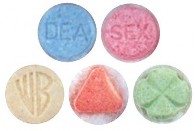
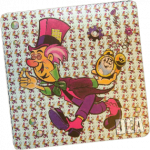
What are common street names?
Common street names include: Acid, Blotter, Blotter Acid, Cubes, Doses, Fry, Mind Candy, Mushrooms, Shrooms, Special K, STP, X, and XTC.
What do they look like?
Hallucinogens come in a variety of forms. MDMA or ecstasy tablets are sold in many colors with a variety of logos to attract youth. LSD is sold in the form of impregnated paper (blotter acid), typically imprinted with colorful graphic designs.
How are they abused?
The most commonly abused hallucinogens among junior and senior high school students are hallucinogenic mushrooms, LSD, and MDMA (ecstasy). Hallucinogens are typically taken orally or can be smoked.
What is their effect on the mind?
Sensory effects include perceptual distortions that vary with dose, setting, and mood. Psychic effects include distortions of thought associated with time and space. Time may appear to stand still, and forms and colors seem to change and take on new significance. Weeks or even months after some hallucinogens have been taken, the user may experience flashbacks — fragmentary recurrences of certain aspects of the drug experience in the absence of actually taking the drug. The occurrence of a flashback is unpredictable, but is more likely to occur during times of stress and seems to occur more frequently in younger individuals. With time, these episodes diminish and become less intense.
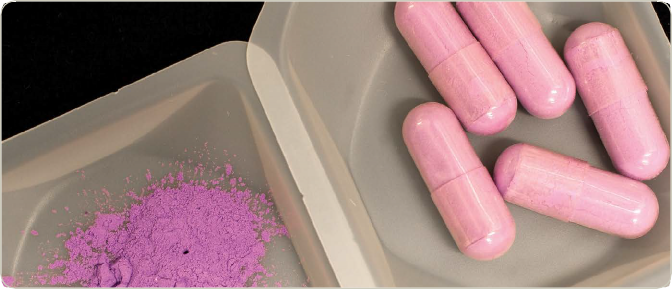
What is their effect on the body?
Physiological effects include elevated heart rate, increased blood pressure, and dilated pupils.
What are their overdose effects?
Deaths exclusively from an acute overdose of LSD, magic mushrooms, and mescaline are extremely rare. Deaths generally occur due to suicide, accidents, and dangerous behavior, or due to the person inadvertently eating poisonous plant material. A severe overdose of PCP and ketamine can result in respiratory depression, coma, convulsions, seizures, and death due to respiratory arrest.
What is their legal status in the United States? Many hallucinogens are Schedule I under the Controlled Substances Act, meaning that they have a high potential for abuse, no currently accepted medical use in treatment in the United States, and a lack of accepted safety for use under medical supervision.
Ecstasy/MDMA
WHAT IS ECSTASY/MDMA?
MDMA acts as both a stimulant and psychedelic, producing an energizing effect, distortions in time and perception, and enhanced enjoyment of tactile experiences.
Adolescents and young adults use it to reduce inhibitions and to promote euphoria, feelings of closeness, empathy, and sexuality. Although MDMA is known among users as ecstasy, researchers have determined that many ecstasy tablets contain not only MDMA but also a number of other drugs or drug combinations that can be harmful, such as methamphetamine, ketamine, cocaine, the over-the-counter cough suppressant dextromethorphan (DXM), the diet drug ephedrine, and caffeine.
In addition, other drugs similar to MDMA, such as MDA or PMA, are often sold as ecstasy, which can lead to overdose and death when the user takes additional doses to obtain the desired effect.
WHAT IS ITS ORIGIN?
MDMA is a synthetic chemical made in labs. Seized MDMA in the U.S. is primarily manufactured in and smuggled across our borders from, clandestine laboratories in Canada and, to a lesser extent, the Netherlands. A small number of MDMA clandestine laboratories have also been identified operating in the United States.
What are common street names?
Common street names include: Adam, Beans, Clarity, Disco Biscuit, E, Ecstasy, Eve, Go, Hug Drug, Lover’s Speed, MDMA, Peace, STP, X, and XTC.
What does it look like?
MDMA is mainly distributed in tablet form. MDMA tablets are sold with logos, creating brand names for users to seek out. The colorful pills are often hidden among colorful candies. MDMA is also distributed in capsules, powder, and liquid forms.
How is it abused?
MDMA use mainly involves swallowing tablets (50-150 mg), which are sometimes crushed and snorted, occasionally smoked but rarely injected. MDMA is also available as a powder. MDMA users usually take MDMA by “stacking” (taking three or more tablets at once) or by “piggy-backing” (taking a series of tablets over a short period of time). One trend among young adults is “candy flipping,” which is the co-abuse of MDMA and LSD. MDMA is considered a “party drug.” As with many other drugs of abuse, MDMA is rarely used alone. It is common for users to mix MDMA with other substances, such as alcohol and marijuana.
What is its effect on the mind?
MDMA mainly affects brain cells that use the chemical serotonin to communicate with each other. Serotonin helps to regulate mood, aggression, sexual activity, sleep, and sensitivity to pain. Clinical studies suggest that MDMA may increase the risk of long-term, perhaps permanent, problems with memory and learning. MDMA causes changes in perception, including euphoria and increased sensitivity to touch, energy, sensual and sexual arousal, need to be touched, and need for stimulation.
Some unwanted psychological effects include: Confusion, anxiety, depression, paranoia, sleep problems, and drug craving. All these effects usually occur within 30 to 45 minutes of swallowing the drug and usually last 4 to 6 hours, but they may occur or last weeks after ingestion.
What is its effect on the body?
Users of MDMA experience many of the same effects and face many of the same risks as users of other stimulants such as cocaine and amphetamines. These include increased motor activity, alertness, heart rate, and blood pressure.
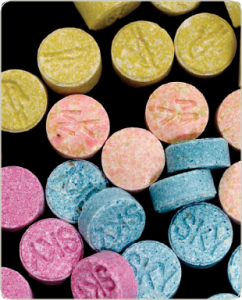
What are its overdose effects?
In high doses, MDMA can interfere with the body’s ability to regulate temperature. On occasions, this can lead to a sharp increase in body temperature (hyperthermia), resulting in liver, kidney, and cardiovascular system failure, and death. Because MDMA can interfere with its own metabolism (that is, its breakdown within the body), potentially harmful levels can be reached by repeated drug use within short intervals.
Which drugs cause similar effects?
MDMA produces both amphetamine-like stimulation and mild mescaline-like hallucinations.
What is its legal status in the United States?
MDMA is a Schedule I drug under the Controlled Substances Act, meaning it has a high potential for abuse, no currently accepted medical use in treatment in the United States, and a lack of accepted safety for use under medical supervision.
Some unwanted physical effects include:
Muscle tension, tremors, involuntary teeth clenching, muscle cramps, nausea, faintness, chills, sweating, and blurred vision.
High doses of MDMA can interfere with the ability to regulate body temperature, resulting in a sharp increase in body temperature (hyperthermia), leading to liver, kidney, and cardiovascular failure. Severe dehydration can result from the combination of the drug’s effects and the crowded and hot conditions in which the drug is often taken. Studies suggest the chronic use of MDMA can produce damage to the serotonin system. It is ironic that a drug that is taken to increase pleasure may cause damage that reduces a person’s ability to feel pleasure.
Ketamine
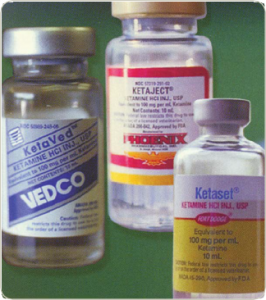
WHAT IS KETAMINE?
Ketamine is a dissociative anesthetic that has some hallucinogenic effects. It distorts perceptions of sight and sound and makes the user feel disconnected and not in control. It is an injectable, short-acting anesthetic for use in humans and animals. It is referred to as a “dissociative anesthetic” because it makes patients feel detached from their pain and environment.
Ketamine can induce a state of sedation (feeling calm and relaxed), immobility, relief from pain, and amnesia (no memory of events while under the influence of the drug).
It is abused for its ability to produce dissociative sensations and hallucinations. Ketamine has also been used to facilitate sexual assault.
WHAT IS ITS ORIGIN?
Ketamine is produced commercially in a number of countries, including the United States. Most of the ketamine illegally distributed in the United States is diverted or stolen from legitimate sources, particularly veterinary clinics, or smuggled into the United States from Mexico. Distribution of ketamine typically occurs among friends and acquaintances, most often at raves, nightclubs, and at private parties; street sales of ketamine are rare.
How is it abused?
Ketamine, along with the other “club drugs,” has become popular among teens and young adults at dance clubs and “raves.” Ketamine is manufactured commercially as a powder or liquid. Powdered ketamine is also formed from pharmaceutical ketamine by evaporating the liquid using hot plates, warming trays, or microwave ovens, a process that results in the formation of crystals, which are then ground into powder.
What are common street names?
Common street names include: Cat Tranquilizer, Cat Valium, Jet K, Kit Kat, Purple, Special K, Special La Coke, Super Acid, Super K, and Vitamin K.
What does it look like?
Ketamine comes in a clear liquid and a white or off-white powder. Powdered ketamine (100 milligrams to 200 milligrams) typically is packaged in small glass vials, small plastic bags, and capsules as well as paper, glassine, or aluminum foil folds. Powdered ketamine is cut into lines known as bumps and snorted, or it is smoked, typically in marijuana or tobacco cigarettes. Liquid ketamine is injected or mixed into drinks. Ketamine is found by itself or often in combination with MDMA, amphetamine, methamphetamine, or cocaine.
What is its effect on the mind?
Ketamine produces hallucinations. It distorts perceptions of sight and sound and makes the user feel disconnected and not in control. A “Special K” trip is touted as better than that of LSD or PCP because its hallucinatory effects are relatively short in duration, lasting approximately 30 to 60 minutes as opposed to several hours.
Slang for experiences related to Ketamine or effects of ketamine include:
-
“K-land” (refers to a mellow & colorful experience)
-
“K-hole” (refers to the out-of-body, near-death experience)
-
“Baby food” (users sink into blissful, infantile inertia)
-
“God” (users are convinced that they have met their maker)
The onset of effects is rapid and often occurs within a few minutes of taking the drug, though taking it orally results in a slightly slower onset of effects. Flashbacks have been reported several weeks after ketamine is used. Ketamine may also cause agitation, depression, cognitive difficulties, unconsciousness, and amnesia.
What is its effect on the body?
A couple of minutes after taking the drug, the user may experience an increase in heart rate and blood pressure that gradually decreases over the next 10 to 20 minutes. Ketamine can make users unresponsive to stimuli.
When in this state, users experience:
- Involuntarily rapid eye movement, dilated pupils, salivation, tear secretions, and stiffening of the muscles.
- This drug can also cause nausea.
What are its overdose effects?
An overdose can cause unconsciousness and dangerously slowed breathing.
Which drugs cause similar effects?
Other hallucinogenic drugs such as LSD, PCP, and mescaline can cause hallucinations. There are also several drugs such as GHB, Rohypnol, and other depressants that are misused for their amnesiac or sedative properties to facilitate sexual assault.
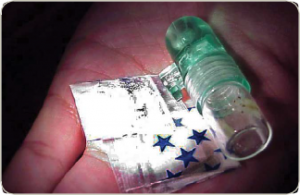
What is its legal status in the United States?
Since the 1970s, ketamine has been marketed in the United States as an injectable, short-acting anesthetic for use in humans and animals. In 1999, ketamine including its salts, isomers, and salts of isomers, became a Schedule III non-narcotic substance under the Controlled Substances Act. It has a currently accepted medical use but some potential for abuse, which may lead to moderate or low physical dependence or high psychological dependence.
LSD
WHAT IS LSD?
LSD is a potent hallucinogen that has a high potential for abuse and currently has no accepted medical use in treatment in the United States.
WHAT IS ITS ORIGIN?
LSD is produced in clandestine laboratories in the United States.
What are common street names?
Common names for LSD include: Acid, Blotter Acid, Dots, Mellow Yellow, and Window Pane.
What does it look like?
LSD is sold on the street in tablets, capsules, and occasionally in liquid form. It is an odorless and colorless substance with a slightly bitter taste. LSD is often added to absorbent paper, such as blotter paper, and divided into small decorated squares, with each square representing one dose.
What is its effect on the body?
The physical effects include dilated pupils, higher body temperature, increased heart rate and blood pressure, sweating, loss of appetite, sleeplessness, dry mouth, and tremors.
How is it abused?
LSD is abused orally.
What is its effect on the mind?
During the first hour after ingestion, users may experience visual changes with extreme changes in mood. While hallucinating, the user may suffer impaired depth and time perception accompanied by a distorted perception of the shape and size of objects, movements, colors, sound, touch, and the user’s own body image. The ability to make sound judgments and see common dangers is impaired, making the user susceptible to personal injury. It is possible for users to suffer acute anxiety and depression after an LSD “trip” and flashbacks have been reported days, and even months, after taking the last dose.
The physical effects include dilated pupils, higher body temperature, increased heart rate and blood pressure, sweating, loss of appetite, sleeplessness, dry mouth, and tremor.
What are its overdose effects?
Longer, more intense “trip” episodes, psychosis, and possible death.
Which drugs cause similar effects?
LSD’s effects are similar to other hallucinogens, such as PCP, mescaline, and peyote.
What is its legal status in the United States?
LSD is a Schedule I substance under the Controlled Substances Act. Schedule I substances have a high potential for abuse, no currently accepted medical use in treatment in the United States, and a lack of accepted safety for use under medical supervision.
Peyote & Mescaline
WHAT ARE PEYOTE AND MESCALINE?
Peyote is a small, spineless cactus. The active ingredient in peyote is the hallucinogen mescaline.
WHAT IS ITS ORIGIN?
From the earliest recorded time, peyote has been used by natives in northern Mexico and the southwestern United States as a part of their religious rites. Mescaline can be extracted from peyote or produced synthetically.
What is its effect on the body?
Following the consumption of peyote and mescaline, users may experience:
Intense nausea, vomiting, dilation of the pupils, increased heart rate, increased blood pressure, a rise in body temperature that causes heavy perspiration, headaches, muscle weakness, and impaired motor coordination
Which drugs cause similar effects?
Other hallucinogens like LSD, psilocybin (mushrooms), and PCP.
What are common street names?
Common street names include: Buttons, Cactus, Mesc, and Peyote.
What does it look like?
The top of the peyote cactus is referred to as the “crown” and consists of disc-shaped buttons that are cut off.
How is it abused?
The fresh or dried buttons are chewed or soaked in water to produce an intoxicating liquid. Peyote buttons may also be ground into a powder that can be placed inside gelatin capsules to be swallowed, or smoked with a leafy material such as cannabis or tobacco.
What is its effect on the mind?
Abuse of peyote and mescaline will cause varying degrees of illusions, hallucinations, altered perception of space and time, and altered body image. Users may also experience euphoria, which is sometimes followed by feelings of anxiety.
What is its legal status in the United States?
Peyote and mescaline are Schedule I substances under the Controlled Substances Act, meaning that they have a high potential for abuse, no currently accepted medical use in treatment in the United States, and a lack of accepted safety for use under medical supervision.
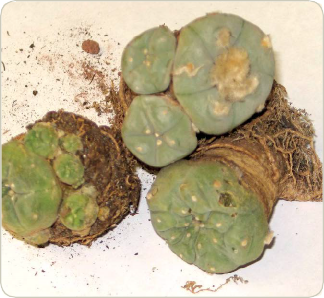
Psilocybin
WHAT IS PSILOCYBIN?
Psilocybin is a chemical obtained from certain types of fresh or dried mushrooms.
WHAT IS ITS ORIGIN?
Psilocybin mushrooms are found in Mexico, Central America, and the United States.
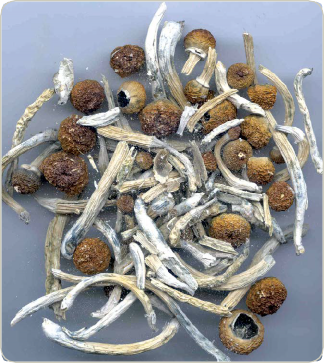
What are common street names?
Common street names include: Magic Mushrooms, Mushrooms, and Shrooms.
What does it look like?
Mushrooms containing psilocybin are available fresh or dried and have long, slender stems topped by caps with dark gills on the underside. Fresh mushrooms have white or whitish-gray stems; the caps are dark brown around the edges and light brown or white in the center. Dried mushrooms are usually rusty brown with isolated areas of off-white.
How is it abused?
Psilocybin mushrooms are ingested orally. They may also be brewed as a tea or added to other foods to mask their bitter flavor.
What is its effect on the body?
The physical effects include nausea, vomiting, muscle weakness, and lack of coordination.
What is its effect on the mind?
The psychological consequences of psilocybin use include hallucinations and an inability to discern fantasy from reality. Panic reactions and psychosis also may occur, particularly if a user ingests a large dose.
What are its overdose effects?
Effects of overdose include longer, more intense “trip” episodes, psychosis, and possible death. Abuse of psilocybin mushrooms could also lead to poisoning if one of the many varieties of poisonous mushrooms is incorrectly identified as a psilocybin mushroom.
Which drugs cause similar effects?
Psilocybin effects are similar to other hallucinogens, such as mescaline and peyote.
What is its legal status in the United States?
Psilocybin is a Schedule I substance under the Controlled Substances Act, meaning that it has a high potential for abuse, no currently accepted medical use in treatment in the United States, and a lack of accepted safety for use under medical supervision.
Source: Drugs of abuse: A DEA resource guide (DEA, 2017)
Additional information: National Institute on Drug Abuse, Commonly Used Drugs Charts

